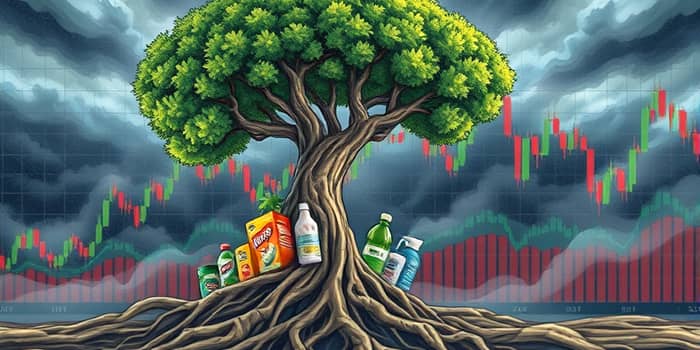
In an era defined by shifting trade policies, fluctuating interest rates, and global economic uncertainty, some sectors shine as beacons of stability. Among these, consumer staples have emerged as a pillar of resilience, offering investors both security and reliable returns. This article explores the fundamentals of this defensive corner of the market, examines its performance during volatile periods, and provides practical guidance for those seeking to anchor their portfolios.
From grocery aisles to household essentials, these companies meet everyday needs and demonstrate remarkable fortitude when other sectors falter. Understanding how consumer staples navigate economic storms can empower investors to make informed decisions, manage risk, and build long-term wealth.
At its core, the consumer staples sector comprises goods that individuals purchase out of necessity. These include food, beverages, personal care items, and cleaning products. Whether times are good or challenging, demand for these essentials remains robust, thanks to the fundamental human need for sustenance and hygiene.
Major players in the space illustrate this breadth, showcasing brands that span continents and demographics. Key companies in this sector include:
These firms have built global supply chains, harnessed brand loyalty, and leveraged scale to maintain a competitive edge. Their products serve billions of consumers daily, generating consistent revenue streams even in downturns.
One of the most compelling aspects of consumer staples is their steady demand regardless of economic cycles. In contrast to luxury goods or discretionary services, households prioritize essentials, ensuring that companies in this sector enjoy predictable sales volumes.
Historical data underscores this resilience. During the last three recessionary periods, consumer staples have outperformed the broad market in recessions, reflecting their defensive qualities. In 2025, when the Vanguard Consumer Staples ETF rallied over 5%, the Consumer Discretionary ETF declined nearly 7%, highlighting how staples can function as a hedge against volatility.
The first half of 2025 was marked by trade tensions, inflationary pressures, and concerns over a potential recession, with some analysts assigning a 60% probability to an upcoming downturn. Even amid these headwinds, staples companies demonstrated exceptional agility.
One notable metric is the sector’s price-to-earnings ratio. By May 2025, the P/E ratio for consumer staples had fallen to 19.8x, down from a three-year average of 28.3x. This shift suggests stocks may be undervalued and poised for a rebound as investors seek stability.
For a clear comparison, consider the following table:
In times of 24-hour news cycles that highlight worst-case scenarios, consumer staples act as a financial lighthouse, guiding portfolios to relative safety. They may not capture headlines like high-flying tech stocks, but their quiet consistency can prove invaluable when markets swing unpredictably.
Beyond capital appreciation, consumer staples are renowned for their track record of maintaining and raising dividends. Income-focused investors often turn to this sector to generate stable cash flows, especially when bond yields appear unattractive.
As of August 2023, the average dividend yield across the sector stood at 2.64%, surpassing the S&P 500’s 1.7% yield. Companies like Kimberly-Clark and Philip Morris have consistently increased payouts through economic cycles, providing shareholders with a dependable income stream.
Several factors underpin the sector’s strength in today’s turbulent markets. Higher import tariffs have elevated the cost of many imports, yet consumer staples companies have shown a remarkable ability to absorb or pass on those costs with minimal demand loss. Their pricing power to pass costs on has been a key differentiator.
Additionally, while a strong U.S. dollar can hurt export-oriented businesses, staples often rely on domestic production and distribution. This insulates them from currency volatility, even as packaging or input costs rise. Finally, recent interest rate cuts by the Federal Reserve have eased borrowing costs, supporting both consumer spending and corporate profitability.
No investment is without risks, and consumer staples face their own headwinds:
Some analysts caution that an excessive rotation into defensive stocks could dampen future returns if economic conditions improve. Balancing expectations is crucial for investors who seek both stability and growth.
Looking ahead, 2025 may mark a “return to normal” for consumer staples, backed by underpinned by healthy consumer balance sheets and solid employment gains. Yet uncertainties remain around trade policy and currency fluctuations.
Beyond pure financial metrics, shifting consumer preferences towards health, sustainability, and ethical sourcing present growth avenues within staples. Brands that innovate with organic products, eco-friendly packaging, or transparent supply chains can unlock premium pricing and deeper customer loyalty.
For investors aiming to harness the benefits of this sector, consider the following strategies:
By adopting a disciplined approach, investors can leverage the defensive nature of consumer staples to cushion portfolios in downturns while capturing upside during recoveries.
Ultimately, investing in consumer staples is about more than just numbers; it’s a vote for reliability, quality, and the everyday comforts that define our lives. By weaving these stable threads into your financial tapestry, you can create a portfolio that not only weathers storms but also stands ready to seize the promise of each new dawn.
References













